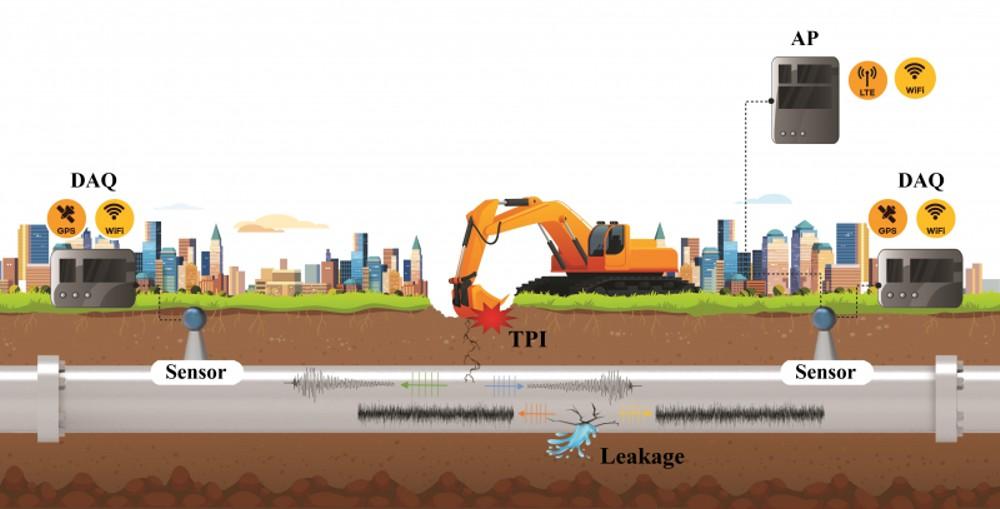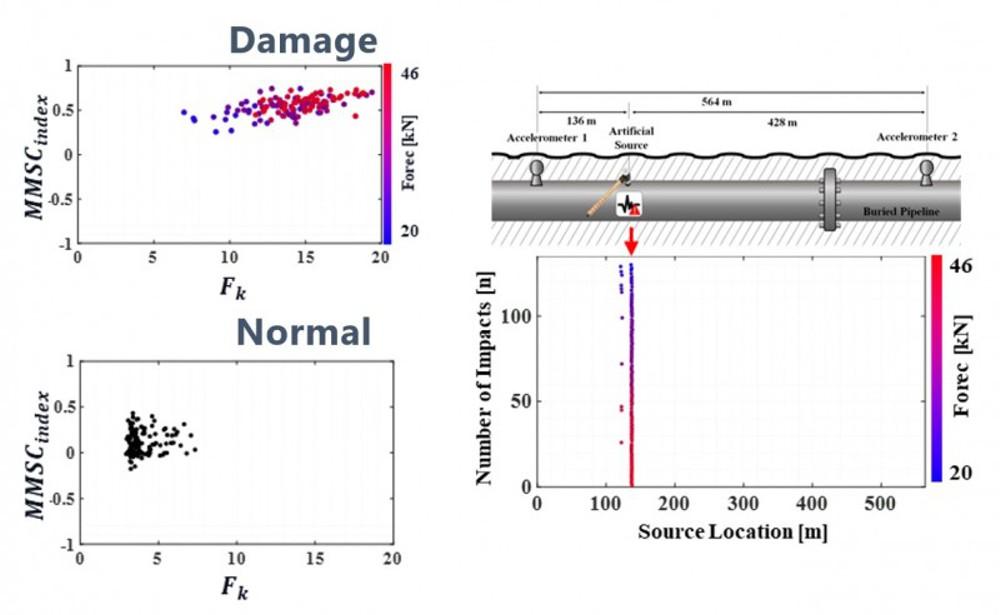R.E.News International-Damage Prevention and Early Detection for Buried Pipelines
 26/03/24-FR-English-NL-footer
26/03/24-FR-English-NL-footer
Prévention des dommages et détection précoce des pipelines enterrés

 Scenario for damage prevention and early detection system for buried pipelines. Credit: Korea Research Institute of Standards and Science (KRISS).-Results of damage analysis and source location. Credit: Korea Research Institute of Standards and Science (KRISS).
Scenario for damage prevention and early detection system for buried pipelines. Credit: Korea Research Institute of Standards and Science (KRISS).-Results of damage analysis and source location. Credit: Korea Research Institute of Standards and Science (KRISS).
L'Institut coréen de recherche sur les normes et les sciences a développé un système de prévention des dommages et de détection précoce pour les pipelines enterrés, empêchant les défaillances de pipeline causées par des interférences de tiers (TPI) et d'autres menaces.
Le TPI est l’une des principales causes de dommages aux canalisations enterrées utilisées pour le transport de l’eau, du pétrole, du gaz et d’autres substances. Les fuites dans les pipelines endommagés entraînent non seulement une contamination de l’environnement, mais présentent également des risques tels que des explosions, des incendies et des dolines. Cependant, la prévention reste un défi pour les entités de gestion des pipelines qui souhaitent détecter les TPI à l'avance.
Le groupe de métrologie non destructive du KRISS a développé un système de surveillance en temps réel qui identifie les activités de dommages réels avant que les pipelines enterrés ne soient endommagés. Lorsque le TPI ou d'autres menaces ont un impact critique juste autour des pipelines, le système le reconnaît comme un risque et émet des alertes précoces pour prévenir les incidents.
La technologie de base repose sur des modèles de mesure et d’analyse précis de l’onde élastique propagée lors de l’impact sur les pipelines. Avec une paire de capteurs distants de plusieurs centaines de mètres le long du pipeline, le système permet de surveiller en temps réel les signaux d'impact entre les capteurs. Cela permet un calcul immédiat de l'heure et du lieu de l'impact, à l'instar des centres sismologiques qui détectent les vibrations et localisent la position de la source d'un tremblement de terre en utilisant l'heure d'arrivée des ondes sismiques.
Les capteurs peuvent être facilement fixés aux parties accessibles exposées depuis les canalisations enterrées, telles que les chambres de vannes ou les trous d'homme. De plus, le système intègre des algorithmes analytiques précis qui réduisent et filtrent efficacement les signaux inutiles tels que le bruit ambiant : trafic, bruit de la vie quotidienne, etc.
L’équipe de recherche a mené de formidables expériences sur le terrain pour valider l’applicabilité pratique du système à de véritables pipelines enterrés en service s’étendant sur plusieurs kilomètres en Corée du Sud. Les résultats ont démontré que le système a détecté avec succès des impacts supérieurs à environ 20 kN avec une précision de plus de 95 %. Étant donné que la force typique provoquant des dommages aux pipelines est souvent de l'ordre de plusieurs centaines de kN ou plus, le système s'est avéré approprié pour la prévention et l'alerte précoce des incidents de dommages aux pipelines.
Les technologies conventionnelles de surveillance des pipelines enterrés se concentrent généralement uniquement sur la détection des fuites après la survenue de dommages. Cette réalisation de KRISS représente donc le premier système de détection précoce au monde des dommages causés aux pipelines sur de longues distances. L'équipe de recherche a réalisé des transferts de technologie vers des entreprises en Corée du Sud et déposé des demandes de brevet aux États-Unis et en Europe.
Le nouveau système peut être appliqué non seulement aux conduites d'eau, mais également à divers types de conduites, notamment celles destinées au transport de pétrole et de gaz ainsi qu'à l'approvisionnement en chaleur. Il peut être utilisé dans les systèmes de surveillance intelligents pour la détection et la gestion en ligne des conditions anormales dans les pipelines enterrés.
Le Dr Dong-Jin Yoon, chercheur principal du Groupe de métrologie non destructive, a déclaré : « Malgré le risque sérieux d'accidents majeurs et de pertes de vies humaines dus aux ruptures de pipelines, nous avons dû nous fier aux rapports de fuites provenant d'informateurs. Cette technologie contribuera à la sécurité publique et aux économies de coûts sociaux.
NJC.© Info National Research Council of Science and Technology
--------------------------------------------------------------------------------------------------------------
 26/03/24-English
26/03/24-English
Damage Prevention and Early Detection for Buried Pipelines

 Scenario for damage prevention and early detection system for buried pipelines. Credit: Korea Research Institute of Standards and Science (KRISS).-Results of damage analysis and source location. Credit: Korea Research Institute of Standards and Science (KRISS).
Scenario for damage prevention and early detection system for buried pipelines. Credit: Korea Research Institute of Standards and Science (KRISS).-Results of damage analysis and source location. Credit: Korea Research Institute of Standards and Science (KRISS).
The Korea Research Institute of Standards and Science has developed a damage prevention and early detection system for buried pipelines, preventing pipeline failures caused by third-party interference (TPI) and other threats.
TPI is one of the main causes of damage to buried pipelines used for transporting water, petroleum, gas, and other substances. Leaks in damaged pipelines not only lead to environmental contamination but also present risks such as explosions, fires, and sinkholes. However, the prevention still has been challenging for pipeline management entities to detect TPI in advance.
The Non-Destructive Metrology Group at KRISS has developed a real-time monitoring system that identifies actual damage activities before buried pipelines are damaged. When TPI or other threats make a critical impact just around pipelines, the system recognizes it as a risk and gives early warnings to prevent incidents.
The core technology is based on precise measurement and analytical models of the elastic wave propagated upon impact to the pipelines. With a pair of sensors several hundred meters apart along the pipeline, the system enables the real-time monitoring of impact signals between the sensors. This provides immediate calculation of the time and location of the impact, similar to seismological centres that detect vibrations and localize source position of an earthquake using arrival time of seismic waves.
The sensors can be easily attached to accessible parts exposed from buried pipelines, such as valve chambers or manholes. Moreover, the system incorporates precise analytical algorithms that effectively reduce and filter out unnecessary signals like noise from surroundings: traffic, daily life noise, and so on.
The research team conducted tremendous field experiments to validate the system’s practical applicability to real buried pipelines in operation spanning several kilometres in South Korea. The results demonstrated that the system successfully detected impacts over about 20 kN with an accuracy of over 95 %. Given that typical force causing pipeline damage often in the range of several hundreds kN or more, the system was found to be suitable for the prevention and early warning of pipeline damage incidents.
Conventional monitoring technologies for buried pipelines usually have only focused on detecting leaks after damages occur. This accomplishment by KRISS, therefore, represents the world’s first early detection system for long-distance pipeline damage. The research team completed technology transfers to companies in South Korea and filed patent applications in both the United States and Europe.
The novel system can be applied not only to water pipelines but also to various types of pipelines, including those for oil and gas transportation as well as heat supply. It can be utilized in smart monitoring systems for the online detection and management of abnormal conditions in buried pipelines.
Dr. Dong-Jin Yoon, a principal researcher from the Non-Destructive Metrology Group, said: “Despite the serious risk of major accidents and loss of life due to pipeline breaks, we have had to rely on leakage reports from informants. This technology will contribute to public safety and social cost savings.”
NJC.© Info National Research Council of Science and Technology
---------------------------------------------------------------------------------------------------------------
 26/03/24-NL
26/03/24-NL
Schadepreventie en vroege detectie van begraven pijpleidingen

 Scenario for damage prevention and early detection system for buried pipelines. Credit: Korea Research Institute of Standards and Science (KRISS).-Results of damage analysis and source location. Credit: Korea Research Institute of Standards and Science (KRISS).
Scenario for damage prevention and early detection system for buried pipelines. Credit: Korea Research Institute of Standards and Science (KRISS).-Results of damage analysis and source location. Credit: Korea Research Institute of Standards and Science (KRISS).
Het Korea Research Institute of Standards and Science heeft een systeem voor schadepreventie en vroege detectie ontwikkeld voor begraven pijpleidingen, waarmee pijpleidingstoringen als gevolg van interferentie van derden (TPI) en andere bedreigingen worden voorkomen.
TPI is een van de belangrijkste oorzaken van schade aan ondergrondse pijpleidingen die worden gebruikt voor het transport van water, aardolie, gas en andere stoffen. Lekkages in beschadigde pijpleidingen leiden niet alleen tot milieuvervuiling, maar brengen ook risico's met zich mee, zoals explosies, brand en zinkgaten. De preventie is echter nog steeds een uitdaging voor pijpleidingbeheerentiteiten om TPI vooraf te detecteren.
De Non-Destructive Metrology Group van KRISS heeft een realtime monitoringsysteem ontwikkeld dat daadwerkelijke schadeactiviteiten identificeert voordat ondergrondse pijpleidingen worden beschadigd. Wanneer TPI of andere bedreigingen een kritieke impact hebben rond pijpleidingen, herkent het systeem dit als een risico en geeft het vroegtijdige waarschuwingen om incidenten te voorkomen.
De kerntechnologie is gebaseerd op nauwkeurige meet- en analytische modellen van de elastische golf die zich voortplant bij een botsing op de pijpleidingen. Met een paar sensoren op enkele honderden meters afstand langs de pijpleiding maakt het systeem real-time monitoring van impactsignalen tussen de sensoren mogelijk. Dit zorgt voor een onmiddellijke berekening van het tijdstip en de locatie van de inslag, vergelijkbaar met seismologische centra die trillingen detecteren en de bronpositie van een aardbeving lokaliseren met behulp van de aankomsttijd van seismische golven.
De sensoren kunnen eenvoudig worden bevestigd op toegankelijke delen die blootliggen door ondergrondse pijpleidingen, zoals klepkamers of mangaten. Bovendien bevat het systeem nauwkeurige analytische algoritmen die onnodige signalen, zoals omgevingsgeluid, zoals verkeerslawaai, lawaai uit het dagelijkse leven, enzovoort, effectief verminderen en wegfilteren.
Het onderzoeksteam voerde enorme veldexperimenten uit om de praktische toepasbaarheid van het systeem te valideren op echte ondergrondse pijpleidingen die in Zuid-Korea in gebruik zijn en zich over meerdere kilometers uitstrekken. De resultaten toonden aan dat het systeem met succes botsingen boven ongeveer 20 kN heeft gedetecteerd met een nauwkeurigheid van meer dan 95%. Gegeven de typische kracht die schade aan pijpleidingen veroorzaakt, vaak in de orde van enkele honderden kN of meer, bleek het systeem geschikt te zijn voor het voorkomen en vroegtijdig waarschuwen van incidenten met pijpleidingschade.
Conventionele monitoringtechnologieën voor ondergrondse pijpleidingen zijn doorgaans alleen gericht op het opsporen van lekken nadat er schade is ontstaan. Deze prestatie van KRISS vertegenwoordigt daarom 's werelds eerste systeem voor vroege detectie van schade aan pijpleidingen over lange afstanden. Het onderzoeksteam voltooide technologieoverdrachten naar bedrijven in Zuid-Korea en diende patentaanvragen in zowel de Verenigde Staten als Europa in.
Het nieuwe systeem kan niet alleen worden toegepast op waterleidingen, maar ook op verschillende soorten pijpleidingen, waaronder die voor olie- en gastransport en warmtevoorziening. Het kan worden gebruikt in slimme monitoringsystemen voor het online detecteren en beheren van abnormale omstandigheden in ondergrondse pijpleidingen.
Dr. Dong-Jin Yoon, hoofdonderzoeker van de Non-Destructive Metrology Group, zei: “Ondanks het ernstige risico op zware ongelukken en het verlies van mensenlevens als gevolg van pijpleidingbreuken, zijn we moeten vertrouwen op lekkagerapporten van informanten. Deze technologie zal bijdragen aan de publieke veiligheid en maatschappelijke kostenbesparingen.”
NJC.© Info National Research Council of Science and Technology
------------------------------------------------------------------------------------------------------------------
Date de dernière mise à jour : 25/03/2024
















